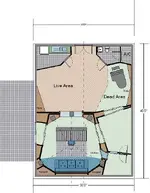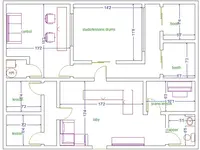The control room and the live room are the most critical. The iso booths can stay as they are and be treated to work fine. They might be better with non-parallel walls, but they are easier to deal with than the larger rooms since their small size means they won't be as likely to have massive bass buildup, so acoustic treatments that focus on mid and high frequencies will do the trick.
Look at the control room that Michael Jones posted and evaluate the wall design he is using (it is basically a perfect example of the design concept for non-parallel walls in a control room). You also need to be conscious of making the control room symmetrical around the mixing position.
As far as the live room goes, look at the shape of the rooms to the right of Michael's control room. One of those, I believe, is his drum room. The theory is that parallel walls allow standing waves to form which can cause the acoustics to severely affect the sound of anything recorded in there (ie. you may get boominess and bass buildup). Non-parallel walls cause the reflected sound to bounce around at odd angles which do not buildup any resonances, and thus make for better recorded sound.
I hope this makes sense. I don't have a way to draw anything for you.
Keep asking questions and probing the answers and you'll get the hang of it. Some basic design ideas that get incorporated early on will save lots of frustration when things sound like crap after its all done.
Darryl.....




